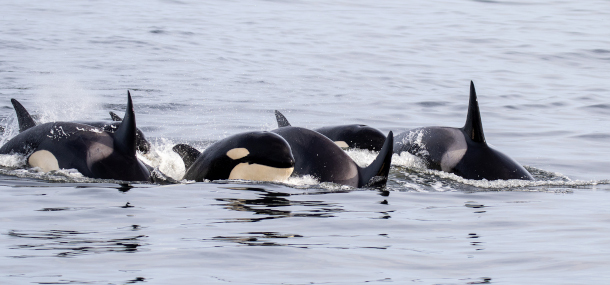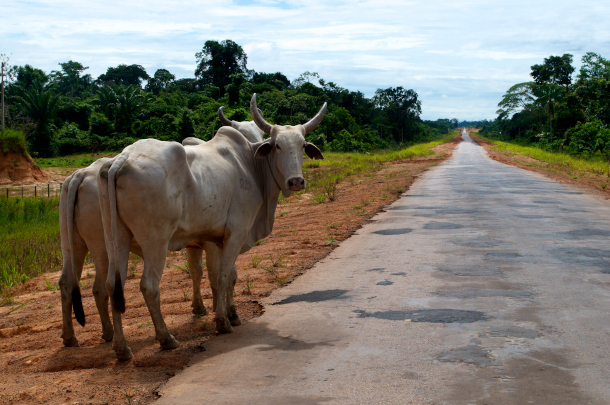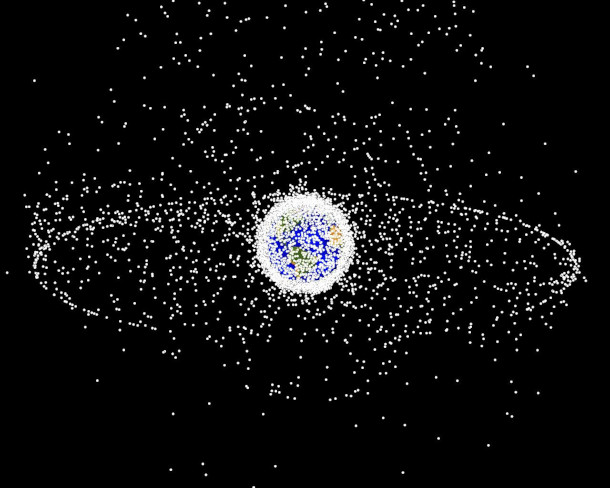Beyond the Headlines
Air Date: Week of November 12, 2021

Killer whales hunt a seal in Monterey Bay, California. (Photo: Robin Agarwal, Flickr, CC By NC 2.0)
Host Bobby Bascomb and Environmental Health News Editor Peter Dykstra discuss a genetic diversity crisis in orca whales, and why non-native water buffalo pose an emerging threat to the Amazon rainforest. In the history calendar they look back to perhaps the first and only trash pickup in space.
Transcript
CURWOOD: It’s Living on Earth, I’m Steve Curwood.
BASCOMB: And I’m Bobby Bascomb.
BASCOMB: Well, it's time for a trip now beyond the headlines with Peter Dykstra. Peter is an editor with Environmental Health News. That's ehn.org and dailyclimate.org. Hey there, Peter, what do you have for us today?
DYKSTRA: Well, hi, Bobby, I've got something that probably not too many folks know, unless they like to read studies from the Norwegian University of Science and Technology on orca whales. Orca pods are very distinct throughout the world, and that according to this research, led by Andrew Foote, orcas may be heading toward a really serious genetic diversity problem which of course can lead to inbreeding and a whole lot of ills.
BASCOMB: Why is there a problem with their genetic diversity?
DYKSTRA: Well, historically, orcas started out in warmer water and 1000s of years ago, the only warm water was near the equator. As the Ice Age ended, orcas spread out to north and south. And now they occupy a lot of very distinct areas, like the Orca pod in Puget Sound. Certainly, the most famous one in US waters. Those orcas never intermingle with other orca populations. And for most of these 1000s of years, they've been breeding unto themselves, that can only lead to bad things.
BASCOMB: Right. Too much inbreeding would cause some, you know, health problems and any disease that they're all susceptible to could wipe out a whole pod, I should think.
DYKSTRA: That's one of the biggest concerns. However, they're also looking at another concern. And that's that the warming of the oceans through climate change, may push orcas even farther away from the equator and to the poles. That could create hardship for orca pods. It also, possibly, theoretically, could drive orca pods together, sharing the same waters and possibly mingling with each other and reducing diversity problem.
BASCOMB: Hmm, yeah, could go either way. Something to keep our eye on anyway. What else do you have for us this week?
DYKSTRA: Well, there's something called buffalo frenzy going in the Amazon rainforest. No, it has nothing to do with buffalo chicken wings, it has nothing to do with the city of Buffalo. It has to do with the water buffalos, and they're increasingly prized by farmers and ranchers that are clearing the Amazon. Water buffalo can provide the same products, meat and dairy, that cows provide but water buffalo are a lot bigger and can provide more of those products, they could do so at even greater harm to the fragile Amazon ecosystem.
BASCOMB: Hmm, well, cows are plenty harmful. I mean, you have to completely cut down the forest to be able to grow them and they can only graze there for so long before you have to cut down new pasture for them, but buffalo are even worse, you say.

The clearing of the Amazon rainforest for grazing domestic water buffalo has encroached on 18 indigenous reserves in the Autazes municipality. (Photo: Kate Evans, CIFOR, Flickr, CC BY-NC-ND 2.0)
DYKSTRA: The water buffalo can occupy larger areas, which is a problem. They can do more damage to those areas, which is a problem. They can out graze the areas that are cleared, which is still another problem. It all adds up to multiplying an already potentially lethal threat to the world's most important rainforest.
BASCOMB: And of course, both Buffalo and cattle are not native to the Amazon. So, you know, generally, when you introduce a lot of non-native species, it's a recipe for disaster for the ecosystem.
DYKSTRA: A water buffalo sized non-native species especially.
BASCOMB: Yeah, for sure. All right, well, what do you have for us from the history books this week?
DYKSTRA: November 12, 1984. The first and, as far as we know, the only trash pickup in space. Two astronauts from the Space Shuttle Discovery, Joseph Allen and Dale Gardner did a spacewalk. They managed to wrangle a disabled satellite, put it in the space shuttles cargo hold and bring it back to Earth. That's one down and about a half a million pieces of space junk to go. Space junk can be as tiny as a bolt, it can be as big, apparently, is a satellite.
BASCOMB: Hmm, yeah. Well, you can certainly see how that could be a huge hazard for space travel. You know, it's just shocking too though. I mean, we've polluted our own planet, and we've even polluted this space around our planet. There's no end to the garbage that we produce, I suppose.

A computer-generated representation of objects in Earth orbit currently being tracked. (Photo: NASA image, Wikimedia Commons, public domain)
DYKSTRA: Right. And picking up that one satellite in 1984 was a bit of a demonstration. In no way should we think that picking up space trash, especially a half a million bits of it is ever going to be easy, because as we all know, in space, you cannot call a tow truck.
BASCOMB: No, certainly not. All right. Well, thanks, Peter. Peter Dykstra is an editor with environmental health news. That's ehn.org and dailyclimate.org. We'll talk to you again real soon.
DYKSTRA: Okay, Bobby, thanks a lot. I'll talk to you soon.
BASCOMB: And there’s more on these stories on the Living on Earth website. That’s loe.org.
Links
Hakai Magazine | “Killer Whales’ Low Genetic Diversity Offers a Warning for the Future”
Mongabay | “Indigenous Lands Under Siege as Buffalo Frenzy Grips the Amazon”
The New York Times Archive “Astronauts Snare Errant Satellite for the First Time”
Living on Earth wants to hear from you!
Living on Earth
62 Calef Highway, Suite 212
Lee, NH 03861
Telephone: 617-287-4121
E-mail: comments@loe.org
Newsletter [Click here]
Donate to Living on Earth!
Living on Earth is an independent media program and relies entirely on contributions from listeners and institutions supporting public service. Please donate now to preserve an independent environmental voice.
NewsletterLiving on Earth offers a weekly delivery of the show's rundown to your mailbox. Sign up for our newsletter today!
 Sailors For The Sea: Be the change you want to sea.
Sailors For The Sea: Be the change you want to sea.
 The Grantham Foundation for the Protection of the Environment: Committed to protecting and improving the health of the global environment.
The Grantham Foundation for the Protection of the Environment: Committed to protecting and improving the health of the global environment.
 Contribute to Living on Earth and receive, as our gift to you, an archival print of one of Mark Seth Lender's extraordinary wildlife photographs. Follow the link to see Mark's current collection of photographs.
Contribute to Living on Earth and receive, as our gift to you, an archival print of one of Mark Seth Lender's extraordinary wildlife photographs. Follow the link to see Mark's current collection of photographs.
 Buy a signed copy of Mark Seth Lender's book Smeagull the Seagull & support Living on Earth
Buy a signed copy of Mark Seth Lender's book Smeagull the Seagull & support Living on Earth

